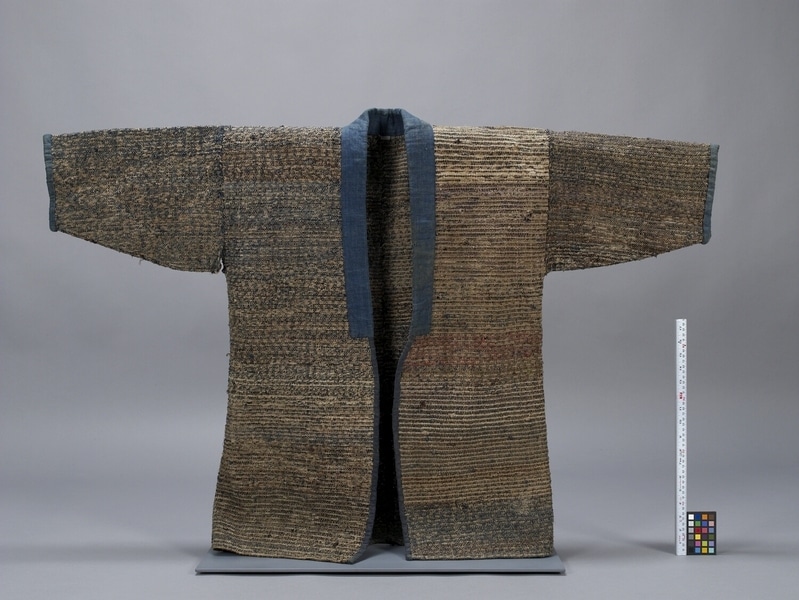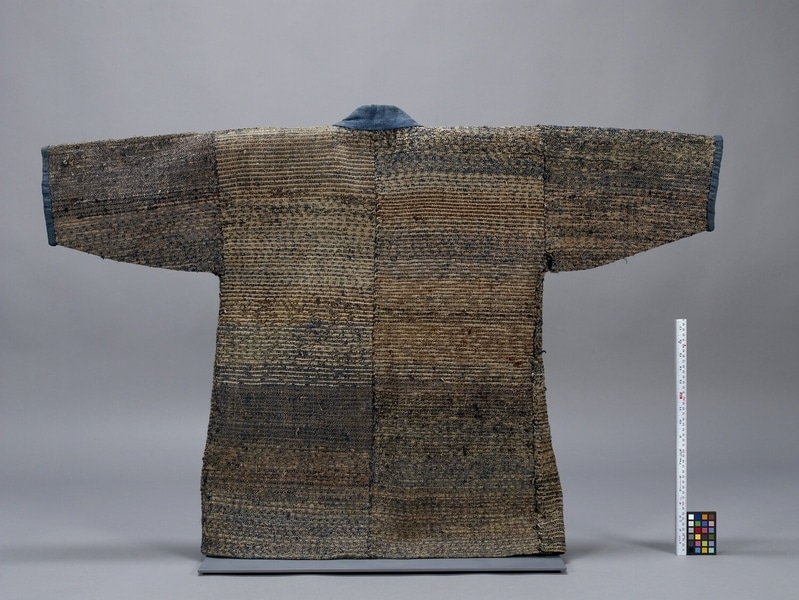Jacket Item Number: 1676/3 from the MOA: University of British Columbia


Description
Brown woven hanten (袢纏, also written as 半天, 袢天, 半纏) made of sakiori (裂織) textile. The woven fabric consists of brown, blue, purple and red pieces. There is a wide blue band around the neck and partway down the centre opening. The opening and sleeve edges are edged with blue trim. The sleeves are slightly tapered. The inside is unlined.
History Of Use
There are different styles of hanten (袢纏) for different uses. It is worn as a winter jacket/coat if padded, a workman’s jacket, by traditional shopkeepers or during a festival. Hanten is casual wear and worn over ordinary clothes, not over kimono.
Specific Techniques
Garment fabric constructed by sakiori (裂織) technique of weaving material from cotton or bast fibre warp and strips of used and torn cotton as the weft. In this garment, 31 to 36 cm wide fabric panels of the vest have been woven from un-dyed cotton warp threads and a weft of dyed and un-dyed cotton rags. Collar and front facing (extends to midway down the front) indigo-dyed woven fabric. Edging around sleeves and front lower facing indigo-dyed cotton fabric. Garment assembled by hand-stitching throughout.
Sakiori (裂織) consists of two characters: saki (裂, “to tear or rip up”) and ori (織, “to weave”). Sakiori was started by farm women in Tōhoku region in Japan during the mid Edo period (around the eighteenth century). They re-used old fabric to make household textiles like rugs and jackets. After various fabrics became readily available, the production of sakiori declined in the late nineteenth century. It is now seen as a green fabric, and some artists use sakiori in their artworks.
Item History
- Made in Toyama, Japan between 1925 and 1940
- Collected by Dai Williams during 1992
- Owned by Dai Williams before May 8, 1994
- Received from Museum of Anthropology Shop Volunteers (Funding source) and Dai Williams (Seller) on May 8, 1994
What
Who
- Culture
- Japanese
- Field Collector
- Dai Williams
- Previous Owner
- Dai Williams
- Received from
- Museum of Anthropology Shop Volunteers (Funding source) and Dai Williams (Seller)
Where
- Holding Institution
- MOA: University of British Columbia
- Made in
- Toyama, Japan
When
- Creation Date
- between 1925 and 1940
- Collection Date
- during 1992
- Ownership Date
- before May 8, 1994
- Acquisition Date
- on May 8, 1994
Other
- Item Classes
- textiles
- Condition
- fair
- Accession Number
- 1676/0003